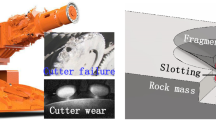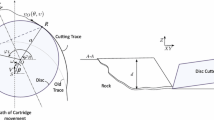Abstract
This paper reports the results of actuated disc cutting (ADC) experiments, conducted with an instrumented tabletop ADC rig on a soft limestone. The experiments were designed to assess the predictions of an ADC model (Dehkhoda and Detournay in Rock Mech Rock Eng 50(2):465–483, 2016) and the validity of the assumptions on which the model is constructed, in particular the invariance of the specific energy on actuation. All the experiments were conducted at the same depth of cut, which was selected to ensure a brittle mode of failure, characterized by the formation of chips. By changing the disc size and actuation amplitude, as well as the actuation frequency and the cartridge velocity, the experiments covered a large enough range of the two numbers controlling the cutting response, to rigorously test the theoretical model and its assumptions. Analyses of the experimental data show in general good agreement with the theoretical predictions, in particular the decrease of the thrust force with increased actuation and the partitioning of the external power between actuation of the disc and translation of the cartridge. The experimental results do not show any significant dependence of the specific energy on actuation.






















Similar content being viewed by others
Abbreviations
- a :
-
Cutter radius
- e :
-
Eccentricity
- d :
-
Depth of cut
- f :
-
Projection of F on (X, Y) plane
- \(x,\,y\) :
-
Scaled coordinates
- t :
-
Time variable
- v :
-
Velocity variable
- \(\varphi\) :
-
Angular position of contact
- \({\dot{p}}\) :
-
Penetration rate
- \(A,\,{\mathcal {A}}\) :
-
Volume of rock removed over an actuation
- \({\mathcal {F}}\) :
-
Scaled force
- F :
-
Total force
- \(F^{{\text {c}}}\) :
-
Cutting force
- \(F^{{\text {f}}}\) :
-
Friction force
- \(K_{{\text {Ic}}}\) :
-
Mode I fracture toughness
- \(P,\,{\mathcal {P}}\) :
-
Power
- \({\bar{P}}_{{\text {a}}}\) :
-
Average power to actuate the disc
- \({\bar{P}}_{{\text {t}}}\) :
-
Average power to translate the cartridge
- \(Q,\,{\mathcal {Q}}\) :
-
Rate of rock removal
- V :
-
Linear velocity
- \(X,\,Y,\,Z\) :
-
Cartesian coordinates
- \(\epsilon\) :
-
Geometric factor
- \(\varepsilon\) :
-
Intrinsic specific energy in ductile mode
- \(\psi\) :
-
Half contact angle
- \(\gamma\) :
-
Orientation of contact segment
- \(\eta\) :
-
Actuation efficiency
- \(\kappa\) :
-
Specific energy factor in brittle mode
- \(\ell\) :
-
Characteristic length
- \(\sigma _{{\text {c}}}\) :
-
Uniaxial compressive strength
- \(\omega ,\,\varOmega\) :
-
Angular velocity
- \(\theta\) :
-
Angular position of disc centre
- \(\upsilon\) :
-
Actuation number
- \(\varXi\) :
-
Specific energy
References
Anonymous (2014) Continuous hard rock cutting trials a success. Int Min Mag. https://im-mining.com/2014/01/31/continuous-hard-rock-cutting-trials-a-success/
de Andrade A, Veldman C, Möller A, de Sousa J, Skea T (2011) Mining machine with driven disc cutters. https://www.google.com/patents/US7934776, US Patent 7,934,776
Dehkhoda S, Detournay E (2016) Mechanics of actuated disc cutting. Rock Mech Rock Eng 50(2):465–483. https://doi.org/10.1007/s00603-016-1121-y
Dehkhoda S, Hill B (2019) Clearance angle and evolution of depth of cut in actuated disc cutting. J Rock Mech Geotech Eng. https://doi.org/10.1016/j.jrmge.2018.12.010
Hood M, Alehossein H (2000) A development in rock cutting technology. Int J Rock Mech Min Sci 37:297–305
Hood M, Guan Z, Tiryaki N, Li X, Karekal S (2005) The benefits of oscillating disc cutting. In: Australian mining technology conference, pp 267–275
Huang H, Detournay E (2008) Intrinsic length scales in tool–rock interaction. ASCE Int J Geomech 8(1):39–44. https://doi.org/10.1061/(ASCE)1532-3641(2008)8:1(23)
Karekal S (2013) Oscillating disc cutting technique for hard rock excavation. In: 47th US rock mechanics/geomechanics symposium, American rock mechanics association
Kovalyshen Y (2015) Analytical model of oscillatory disc cutting. Int J Rock Mech Min Sci 7:378–383. https://doi.org/10.1016/j.ijrmms.2015.04.015
Pickering R, Ebner B (2002) Hard rock cutting and the development of a continuous mining machine for narrow platinum reefs. J S Afr Inst Min Metall 102(1):19–24
Pickering R, Smit A, Moxham K (2006) Mining by rock cutting in narrow reefs. In: International platinum conference ‘Platinum Surges Ahead’, the southern African institute of mining and metallurgy
Richard T, Dagrain F, Poyol E, Detournay E (2012) Rock strength determination from scratch tests. Eng Geol 147–148:91–100. https://doi.org/10.1016/j.enggeo.2012.07.011
Sandvik-Mining (2012) Sandvik reef miner mn220. www.miningandconstruction.sandvik.com. Accessed 10 Aug 2018
Sugden D (2005) Innovation through design. Aust J Mech Eng 2(1):1–9. https://doi.org/10.1080/14484846.2005.11464475
Acknowledgements
The authors would like to thank Rachel Xu and Bryce Hill for their assistance in conducting analyses, Greg Lupton and Stephen Banks for the design and commissioning of Wobble, and Minerals Research Institute of Western Australia, Mining3 and CSIRO for their support of the project.
Author information
Authors and Affiliations
Corresponding author
Additional information
Publisher's Note
Springer Nature remains neutral with regard to jurisdictional claims in published maps and institutional affiliations.
Rights and permissions
About this article
Cite this article
Dehkhoda, S., Detournay, E. Rock Cutting Experiments with an Actuated Disc. Rock Mech Rock Eng 52, 3443–3458 (2019). https://doi.org/10.1007/s00603-019-01767-y
Received:
Accepted:
Published:
Issue Date:
DOI: https://doi.org/10.1007/s00603-019-01767-y




